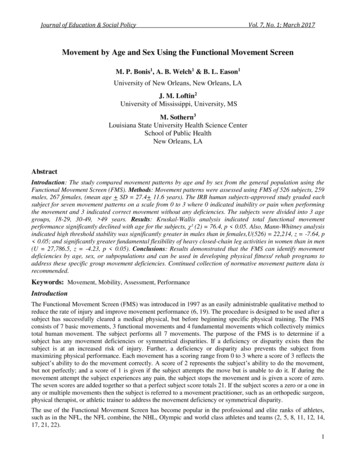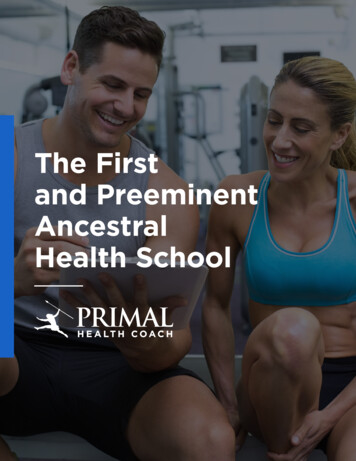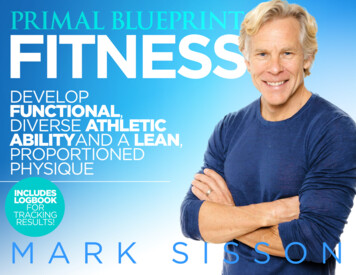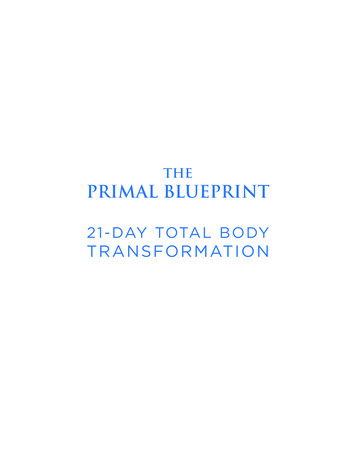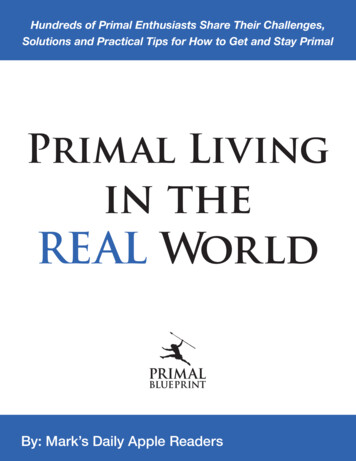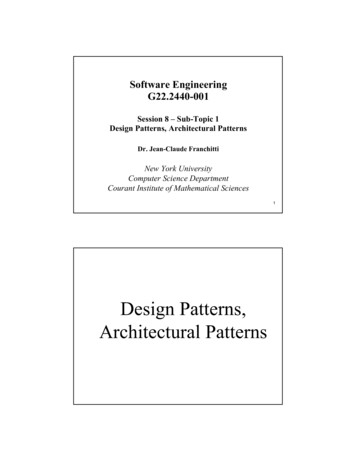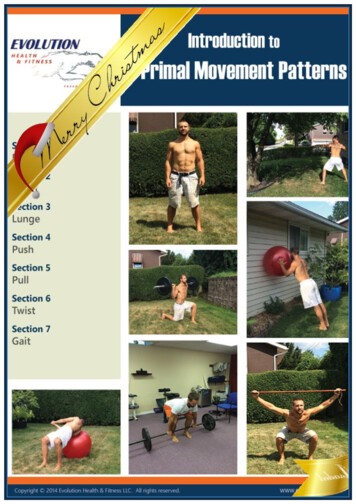
Transcription
7 Primal Movement PatternsCopyright 2014 Evolution Health and Fitness LLC.All rights reserved.www.evo-health.com
7 Primal Movement PatternsNick HorowskiAn Introduction to the 7 Primal Movement PatternsThese are seven movements, as coined by Paul Chek, in which we can breakdown our activities that we do every day. There are many variations of these bypeople, some with a movement or two more and some with less, but are allabout the same.They are the requisite forms of movement that we should be able to dothrough a full range of motion and complete pain free in order for ourmovement to be considered normal. The movements include the following:Bend – Squat – Lunge – Push – Pull – Twist – Gait.In this eBook I will be covering the basics of the Primal Movement Patternsand will also go into greater depth on each one so that you are able to betterimplement them into your own training programs. These can all be put intoboth work outs and work-ins depending on the intensity you use andbreathing patterns. I want to state that these next few steps will not substitutefor learning proper program design, which is very in depth if done correctly, butto give you some ideas about how and where to put specific movements inyour regular routine.Copyright 2014 Evolution Health and Fitness LLC.All rights reserved.www.evo-health.com
7 Primal Movement PatternsBEND“Lift with your knees!” There are just too many good quotes out there that I couldn’tresist. Yes, your knees will be involved with a lift, but if you don’t learn to properly useyour back when lifting then it certainly will get hurt (i.e. “I bent over the pick up thepencil and my back went out.”).It wasn’t the weight it is because your form is bad, your back is weak since you onlysquat and are afraid to bend and that was just the last straw.Again get those feet straight ahead, but now your head will stay in neutral with therest of the spine as you bend over. Begin your movement by shooting your hips backand only bending the knees to about 20 degrees as this allows for maximumrecruitment of the glutes which really should be working here, but are often weak.You will bend down as far as is comfortable without letting the spine come out ofneutral position and then returning to the top. You can now slowly and safely begin tostart lifting your child or bag of groceries again properly.To me there is just something amazing about bending over and picking up somethingheavy. It encompasses my favorite movement which happens to be the deadlift and italso certainly has quite a bit of practicality.Copyright 2014 Evolution Health and Fitness LLC.All rights reserved.www.evo-health.com
7 Primal Movement PatternsThink how many times each day you bend over to pick something up. Notice I saidbend over and not squat down. This is a very important distinction and we must beable to do both to have full capacity of human movement.KNEELING BENDThis is a great movement for those who are afraid to bend, have extremely weak backmuscles or are recovering from surgery and want to start introducing the bend (peryour surgeon’s approval). It can help to build low level endurance and introduce properform before progressing into a standing position.HYPEREXTENSIONSI am not a fan of the name (you should not necessarily go past neutral depending onyour spinal angle as measured by a skilled physical therapist or C.H.E.K Practitioner),but the hyperextension bench either parallel to the ground or at a 45 degree angle areboth great for building strength and amazing endurance of the posterior chain.Copyright 2014 Evolution Health and Fitness LLC.All rights reserved.www.evo-health.com
7 Primal Movement PatternsDEADLIFTSimply a classic. Put a bar on the floor, load it up with weight and pull it with perfectform to the top. To build up a strong back and core you know where to start. Low reps,medium reps or high reps depending on your goals this is just a great way to go.SUMO DEADLIFTSee above and like we covered last week great for keeping the low back and sacrumstable. Also very functional. Think how many times you put your feet around somethingand pick it up. This will keep you strong to do so.Copyright 2014 Evolution Health and Fitness LLC.All rights reserved.www.evo-health.com
7 Primal Movement PatternsELEVATED DEADLIFTI like to do this with a normal and sumo stance. Each has its advantages. Elevating asumo deadlift brings you to the same height as a normal deadlift and prepares you tohave to get down to the floor and pick up that bag of manure for the garden out back.If you are looking for an extreme range of motion then keep a conventional stance.This is a great way to get a super strong back provided you have built up to it.SINGLE LEG DEADLIFTGolfers listen up. Bend down and pick the ball up out of the cup after that birdie andhow do you do it? Kick one leg back and bend the other as you pick it out and smile.I also like it because we are very unilateral beings. We walk, run and sprint with oneleg pushing off at a time. Here is another great way to build that in.There are certainly more forms of the bend, but again I wanted to focus on the basics.The bend can often be combined with the pull as both are extension based movementswhich we are often lacking secondary to our seated positions.Copyright 2014 Evolution Health and Fitness LLC.All rights reserved.www.evo-health.com
7 Primal Movement PatternsSQUATAs the saying goes “squatting is bad for your knees.” This will never get old andcouldn’t be more wrong.A quote that I like a lot better from Dan John is that “squatting is not bad for yourknees, the way you squat is bad for your knees.” That’s right if you have stood up orsat down in any form today then you have squatted and need to keep reading.There is of course a proper way to squat to keep your body in optimal alignment. Eventhis has much debate, but I will give you what I feel is the best way that has workedfor me as well as hundreds of my patients and clients.Find a fixed point straight ahead that you can focus on so your head stays in the sameposition. Make sure that your feet are pointing straight ahead or turned out up to 15degrees, but make sure each foot is doing the same thing.As you begin to go down shift your hips back slightly and think about spreading thefloor apart with your feet. Go down as far as you feel comfortable with your backstaying in a neutral position and return to the top.This is now what to use the squat for and to give you some variety Copyright 2014 Evolution Health and Fitness LLC.All rights reserved.www.evo-health.com
7 Primal Movement PatternsBODYWEIGHT SQUATThis is the gold standard to which all squats are compared. You must get this one rightbefore you move on to the others because you must achieve proper form here firstbefore adding weight.SWISS BALL WALL SQUATI’ve said it before and I’ll say it again here. The Swiss Ball is an excellent piece of exerciseequipment. When put behind the back up against the wall it can make the basicbodyweight squat a little simpler for those who are still struggling with it.Copyright 2014 Evolution Health and Fitness LLC.All rights reserved.www.evo-health.com
7 Primal Movement PatternsBOX SQUAT/SIT TO STANDSUsing a box to squat down is something that has been used in the powerlifting worldfor years and can be a great benefit for those first learning to put the bar on their back.It can be used to teach depth, how to sit into a squat, work on explosion out of thebottom and even decrease give a high load training effect without as much muscularand central nervous system fatigue.Compare this to a sit to stand just using a simple chair is also a great option for thosejust making sure they can get up and out of a chair or off the toilet without assistance.BACK SQUATNow time for the “king of all exercises.” Put a bar on your back, go down and comeback up. I have found these to be great for building strength when getting into the 35 rep range, but for a real treat I like cranking them up to 20-30 reps.Copyright 2014 Evolution Health and Fitness LLC.All rights reserved.www.evo-health.com
7 Primal Movement PatternsFor some insight on this I encourage you to read the book Super Squats by Randall J.Strossen. He shows you how to put on some serious muscle with a program doingheavy weight squats for high reps. I have done this before and seen amazing results.These are not for the faint of heart and you must make sure that your recovery is spoton because when it is these can send your testosterone and growth hormone throughthe roof. Sleep, working in and eating right will be critically important.FRONT SQUATThe front squat is an amazing exercise that does much more than meets the eye. Herewe come across an exercise that has great benefits of the squat, but also is tremendousat strengthening the upper back as well.This is so important for many of us with in increased thoracic kyphosis or roundedupper back from sitting all day and staring at computer screens.Copyright 2014 Evolution Health and Fitness LLC.All rights reserved.www.evo-health.com
7 Primal Movement PatternsGOBLET SQUATThis is a front squat with a dumbbell or kettlebell and can be a great way to transitioninto the front squat as not as much thoracic, shoulder and wrist range of motion isrequired.OVERHEAD SQUATThis is how to test if somebody has true range of motion in every joint in the body.That’s right head up, full shoulder and thoracic range of motion, a stable lumbar spine,great hip mobility as well as getting the motion from the ankles.Copyright 2014 Evolution Health and Fitness LLC.All rights reserved.www.evo-health.com
7 Primal Movement PatternsZERCHER SQUATAnother slick alternative to change up the loading on the squat is the Zercher squatwhere one holds the bar in the crux of their elbows. It can be used for those with awrist/hand injury or even a shoulder injury when you are unable to get your handsback on the bar.SUMO SQUATHere is another variation that is great for strengthening the hip adductors or inside ofthe leg and can be used with any of the above variations. I am a big fan of using thisfor those with an unstable low back and sacrum because it allows for force closure ofthe hip bones on the sacrum. This stability is critical for those that have a lot of lowback pain. It is also nice to add a different stimulus to the body and is also used inmany powerlifting circles.Copyright 2014 Evolution Health and Fitness LLC.All rights reserved.www.evo-health.com
7 Primal Movement PatternsSQUATTING DEPTHIn a lot of lifting competitions full squat depth is considered when the hip crease isbelow the top of the knee or the femur is parallel to the ground. When it comes to theindividual it depends on one’s goals.If you are lifting then this is where you need to hit. If you are trying to just get by youneed to be able to get down to an average height toilet seat which is 16 inches andthe same goes for the average chair.I feel that everybody should be able to hit a rock bottom or “ass to the grass squat.”This would be full expression of human movement and is how our ancestors and manypeople in the so called third world sit.It is something that I still am working on from so many years of sitting and I encourageyou to do the same.This is by no means a complete list, but just something to get you started with a littlebit of variety. It is still imperative that you master the basics before jumping into asumo front squat on a low box with chains.Remember not to always chase the new and shiny object as it does not always fit inwith what you need.Copyright 2014 Evolution Health and Fitness LLC.All rights reserved.www.evo-health.com
7 Primal Movement PatternsLUNGEWait a second. Squat maybe, bend okay, but really a lunge? YES! You still lunge downand tie your shoelace, step over things with a long stride and even go up and downstairs and inclines.Let’s just make sure to learn to do it right.Take a long step forward with the foot facing straight ahead, bend both knees whilegoing down as far as you feel comfortable and push off the front foot to return to thestarting position.Sounds simple and it is as long as you make sure that your knee is tracking in line withyour second toe.Here is the way to go for a great butt for men and women. It will build rock hard glutes.This strength in the hips are vital for sports and also critical as we age. Do not overlookthe lunge when in the gym, on the ball field or in the home. Be sure to keep it in yourtraining program.Copyright 2014 Evolution Health and Fitness LLC.All rights reserved.www.evo-health.com
7 Primal Movement PatternsSPLIT SQUATTake a wide stance forward and drop on down. It is a great way to introduce the lungepattern into your repertoire of movements. I often like to have people put a chair orbench in front of their forward leg to help show them how to drop down properly.Make sure you are ready to be a little sore the next day or two if this is your first timewith these. They really do work.FORWARD/WALKING LUNGENow we get into some more dynamic movement. Learning to stride forward andaccept weight with great form is essential to stabilizing the hips and spine. This willhave great carryover to sport and working around the house to prevent injury. Progressinto the walking lunge only when you have mastered the forward lunge. It is a largejump to the nervous system, as will all of the following lunges, if the basics are notcompleted first.Copyright 2014 Evolution Health and Fitness LLC.All rights reserved.www.evo-health.com
7 Primal Movement PatternsFRONT 45 DEGREE LUNGE, SIDE LUNGE,BACK 45 DEGREE LUNGE, REVERSE LUNGEThese are all great for learning to accept weight at different angles and certainly keepyou very strong. If they become easy adding them in with a medicine ball twist cancertainly spice them up and really strengthen the core.CURTSY LUNGEI put this one separate from the others as I feel it has a unique benefit. The way that itis able to stretch the glute and hip external rotators when under load is tremendous.This has great importance as many people have difficulty recruiting these musclesmaximally. They are the big supinators for the lower extremity so those with collapsingknees and arches take note. Your feet are flat for a reason. Poor inner unit functioningand weak lower extremity supinators cause a collapse all the way down to the feet.Okay, now it is your turn. Make sure that you are not missing out on an incrediblyimportant movement in the lunge. Jump into it where you are ready. Remember aswith all exercises that you do not get points for adding weight too quickly or going toa jumping lunge before you can perform the basic split squat.Copyright 2014 Evolution Health and Fitness LLC.All rights reserved.www.evo-health.com
7 Primal Movement PatternsPUSHThis is another biggie whether closing a door, using your arm to roll over in bed orpushing yourself up off the floor. I still like the good old fashioned push up to practiceyour push.Start in neutral spine position with elbows extended, hands directly under shoulderswith fingers straight ahead.Think of screwing your hands into the floor and driving your elbow pits forward.Unlock your elbows and push them toward your hips (not flaring out) going down asfar as you feel comfortable and return to top position.Up to this point in our series on the Primal Pattern Movements we have coveredmovements that use primarily the lower body. Of course all movements includemuscles from the entire body, but now we are going to switch over to those with anemphasis on the upper body. Before continuing I want to bring up the differencebetween an open chain and a closed chain movement.OPEN KINETIC CHAINWhen an extremity is moving against a force it is free to move. Think throwing a ball,pulling weeds or closing a door. I do not like to do much open chain movements forthe lower extremity as it does not have much carryover to the world with the exceptionof striding during gait and the legs during swimming.Copyright 2014 Evolution Health and Fitness LLC.All rights reserved.www.evo-health.com
7 Primal Movement PatternsCLOSED KINETIC CHAINThe closed chain always wins. Think about the squat, bend or lunge we covered overthe last few weeks. We were never able to overcome the immovable force we weregiving force to. This can apply to both the upper and lower extremities much morethan open chain. Each time we push off during gait, stand up or bend over we areusing this for the lower extremities. Using the push up and pull up are great ways forswimmers to help get through the water better (yes during swimming the upper bodyis functioning in a closed kinetic chain so think about that for your training program).Also, think pushing up from a chair or pulling on something to help you get off theground.Push Up/Wall Push UpThese are great starting points for the push pattern, but as we have covered beforedon’t try to move to fast. Make sure your form is spot on with a wall push up beforedropping to the ground. I am also a huge fan of closed kinetic chain movements forshoulder health. They help to allow for proper recruitment of the rotator cuff andstabilization of the scapula. Even something as simple as a mammalian crawl can be agreat way to begin recovering from shoulder injury.Copyright 2014 Evolution Health and Fitness LLC.All rights reserved.www.evo-health.com
7 Primal Movement PatternsBILATERAL CABLE PUSHTake those cables over each shoulder and push ahead. I like to start here and then goto the single arm pushing as it leaves out the transverse (rotational) plane and makesit an easier learning process.SINGLE ARM CABLE PUSHAs soon as ready get into the single arm work. We don’t often push with two arms inthe closed chain so being able to integrate the single arm work will be critical to propermovement. We can often handle more weight per arm when getting into the singlearm work and therefore want to progress here to reach that maximal strength. Also amust for any throwing athletes (or parents).Copyright 2014 Evolution Health and Fitness LLC.All rights reserved.www.evo-health.com
7 Primal Movement PatternsSWISS BALL DUMBBELL PRESSOne of my favorites and for those of you without a great cable set this is certainlysomething to throw in. It can be done with one or both arms and certainly offers greatstability for the core and backside of the body. The other critical benefit is that it allowsthe scapula to move freely on the ball.This is something that cannot happen on a normal bench and why I prefer the SwissBall to keep from impinging the glenohumeral joint. Heck you can even do a barbellpress on the Swiss Ball, but be sure that whenever doing Swiss Ball exercises that youhave a high quality one that is puncture proof.There you have it. A nice introduction to another movement so get on pushing! Staytuned in for next week when we work the antagonist movement, the pull.Copyright 2014 Evolution Health and Fitness LLC.All rights reserved.www.evo-health.com
7 Primal Movement PatternsPULLThis can be pulling a door open, reaching out and grabbing something off the counteror even moving a couch across the floor as I just did recently. I like to use bands whenteaching the pull hooked onto something stable.A simple row by grabbing two handles is a great place to start. Grab both handles witharms extended. Pull both elbows into your side while squeezing your shoulder bladesstraight back. Make sure that your shoulders do not tip forward and return to thestarting position.In my opinion this, like the bend, is another highly neglected movement. It is not oftenpracticed or trained in the gym and if it is the form is often poor. I feel that this is thereason of so many of the neck and shoulder problems because we have an imbalancebetween the pushing and pulling muscles.Those that are pushing muscles are on the front of the body and we see them moreand because of this tend to be trained and focused upon more. Unfortunately thisleads to more rounded shoulder and forward head posture. Let’s explore a few pullingmovements to help bring you back into balance.Copyright 2014 Evolution Health and Fitness LLC.All rights reserved.www.evo-health.com
7 Primal Movement PatternsDOUBLE ARM CABLE ROWHere is a great introduction to rowing. Reach out and grab a handle with each hand.Bring your elbows into your side, keeping your forearms parallel to the ground andsqueezing your shoulder blades together.SINGLE ARM CABLE ROWThis can be done a huge variety of ways. For simplicity we will do one today andaddress many others in the future. Start by reaching out for a cable or band and placethe opposite foot forward in a split stance. Start by twisting from the trunk and pullingyour hand toward your armpit as if pulling a bow and arrow. Make sure that yourforearm stays parallel with the cable and you pull your shoulder blade across the back.Copyright 2014 Evolution Health and Fitness LLC.All rights reserved.www.evo-health.com
7 Primal Movement PatternsBENT OVER ROWThis can be done with any type of weight such as barbell, dumbbell, kettlebell or evensandbag. The premise is the same. Grab the weight and bend over keeping good form(see blog on the bend movement) and pull the weight into your midsection. Make sureto really squeeze your shoulder blades together and do not allow your shoulders totip forward. Also make sure to keep your chin tucked in.INVERTED ROWStill my favorite place to start is with the inverted row. It is a closed kinetic chainmovement like we talked about last week and is great to build a stable shoulder girdle.Fix a barbell in a rack or grab a hold of a set of rings and pull your chest to them. Justas in the bent over row squeeze the shoulder blades again and keep that chin tucked.If it is too hard set the bar/rings up higher and if it is easy set them down, put yourfeet up or strap on a weight vest.Copyright 2014 Evolution Health and Fitness LLC.All rights reserved.www.evo-health.com
7 Primal Movement PatternsPULL UPNow we get to “the upper body squat.” It is called this because of the tremendousmuscle recruitment and strength needed to complete a strict pull up with good form.It really is a very simple and effective movement. Jump up and grab a bar or ringsoverhead. “Pull” your chest “up” to the bar. That is it provided you don’t flare yourelbows, stick out your chin and be sure to keep the shoulder blades down and back atthe top of the movement.Now it is your turn and really get out there and start pulling. This movement can dowonders for your posture when matched with proper stretching.Copyright 2014 Evolution Health and Fitness LLC.All rights reserved.www.evo-health.com
7 Primal Movement PatternsTWIST“Hey Baby, Let’s Do the Twist!”The twist pattern is often combined with other patterns as a lot of them are. Here wesee it when throwing a ball especially. We are combing a twist, push and lunge all intoone for a great movement.Here woodchops and different rotational exercises on the Swiss ball are excellent totrain the pattern!This twist is a great exercise that I feel is much underutilized. Probably because it is nota sexy exercise to do, but it has so much carryover since there are many exercises thatcombine the twist with other of the Primal Pattern Movements we have been talkingabout. Take just throwing a ball. This can be broken down into a push, twist and lunge.That is a whole lot going on at once that your body really better be able to handle socheck out what we have here to get you twisting.Copyright 2014 Evolution Health and Fitness LLC.All rights reserved.www.evo-health.com
7 Primal Movement PatternsPRONE BALL ROLLHere is a great way to introduce the twist. Just lie down with your chest on the ball,hug it and turn side to side.Very simple and effective when building up your twist.PRONE TWISTERHere is a great way for swimmers to twist since the lower body is in an open chain andmust stabilize the ball. Get in pushup position on the ball and turn your feet side toside.Be sure that your inner and outer units are strong enough to handle this or just slidethe ball in closer to your trunk.Copyright 2014 Evolution Health and Fitness LLC.All rights reserved.www.evo-health.com
7 Primal Movement PatternsSWISS BALL RUSSIAN TWISTI am a big fan of this to work on hip stabilization with a twist introduction. It is alsogreat for getting the spine to rotate very well. Lie on your back on the ball and keepthe hips up.Start with your arms straight in front of you and twist up onto one shoulder. Pausehere and transition to the other shoulder making sure to keep the movement smooth.SUPINE LATERAL BALL ROLLHere is an exercise you can get a lot done with. Not only will it help with your bendand squat, but also brings into play the pull and twist as well. Start again on your backon the ball with your arms straight out to the side.Keeping your shoulders square to the floor shift your shoulders and feet to one side,hold and then return to the other side.Copyright 2014 Evolution Health and Fitness LLC.All rights reserved.www.evo-health.com
7 Primal Movement PatternsBODYWEIGHT WOODCHOP AND CABLE WOODCHOPThis is one of my favorite exercises overall. I recently introduced it to one of myoccasional training partners and he was amazed when we did it heavy what it did forhim throughout his entire body.The movements are the same, except with the cable woodchop start perpendicular toa cable machine and grasp the handle with your outside hand first. You will take a littlewider stance and start with your arms up toward the weights.Your weight will be about 70% to that foot and you will shift it as you drive your armsdown and through so that your hands are now on the outside of your other foot.Return and repeat, but be ready for how much control of the inner unit and outer unitsthis takes as well as being proficient in the lunge and push patterns.Time for you to get out and do your best Chubby Checker impression.Yes, I love oldies so get used to the references.Copyright 2014 Evolution Health and Fitness LLC.All rights reserved.www.evo-health.com
7 Primal Movement PatternsGaitThis can be many different forms from walking to running to sprinting. Each of usshould be able to still run and sprint into late life, but most people stop doing so aftertheir teenage years and lose this ability.Get out go for a run, play tag, shoot some hoops.Just get out and move!With all of these movements it can always be beneficial to find a local CHEK Practitioneror highly skilled physical therapist to check your form and write an exercise programfor your specific body encompassing all of the Primal Pattern Movements.So You Want to Learn to Walk?Make sure that you have first perfected the infant development patterns that I talkedabout a few months ago. You must remember that these are a prerequisite to beingable to walk, run and sprint properly.There are often imbalanced side to side in the body and this is why people notice whenthey walk that one leg turns out, one arm swings more than another, one leg stepsmore or even that a shoe has a different wear pattern than another.Copyright 2014 Evolution Health and Fitness LLC.All rights reserved.www.evo-health.com
7 Primal Movement PatternsAll of these must be addressed and you should seek out a C.H.E.K Practitioner or highlyskilled physical therapist to have these addressed to truly address any problems withyour gait patterns.WALKINGDuring walking one foot must always remain on the ground. Anything more and youmove on to running. I listed some of the problems associated with any form of gait inthe previous paragraph, but let’s make that a little more complete so you canunderstand all of what can be going on when moving from one place to another. Stride LengthPronation (assessing lower extremity, not just foot)Hip Rotation/Out ToeingTrendelenburgArm SwingShoe WearRUNNINGDuring running there are brief periods where both feet are off of the ground. This isdone at a higher speed than walking and because of this causes more force. Runningcan be done in straight lines forward, around turns, cutting sharply and backward. Allof the problems identified in walking are amplified here because of the increasedintensity.Copyright 2014 Evolution Health and Fitness LLC.All rights reserved.www.evo-health.com
7 Primal Movement PatternsSPRINTINGWhen it comes to being able to perform normally as a human sprinting is somethingthat I feel we should still be able to do at any age. It is a form of running near or at topspeed for shorter distances.I feel that it has tremendous importance because it would have still allowed us toescape dangerous situations in the past no matter what our age. We did not have timeto warm up to not pull a muscle so our bodies had to be performing optimally. Even ifyou are not ready to do this right now, I encourage you to start building sprints intoyour life.Copyright 2014 Evolution Health and Fitness LLC.All rights reserved.www.evo-health.com
7 Primal Movement Patterns N ick H orowski An Introduction to the 7 Primal Movement Patterns These are seven movements, as coined by Paul Chek, in which we can break down our activities that we do every day. There are many variations of these by people, some with a movement or
